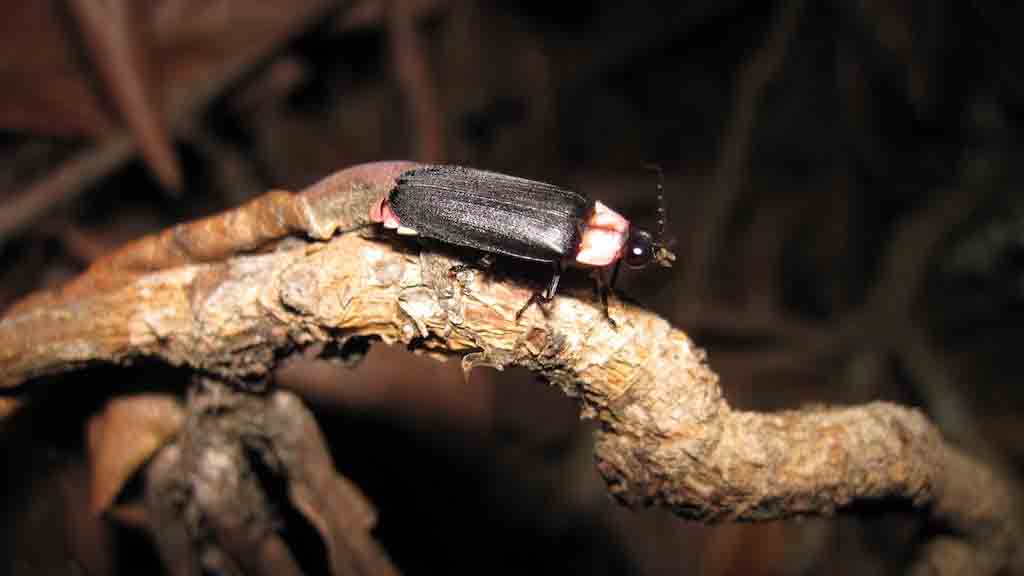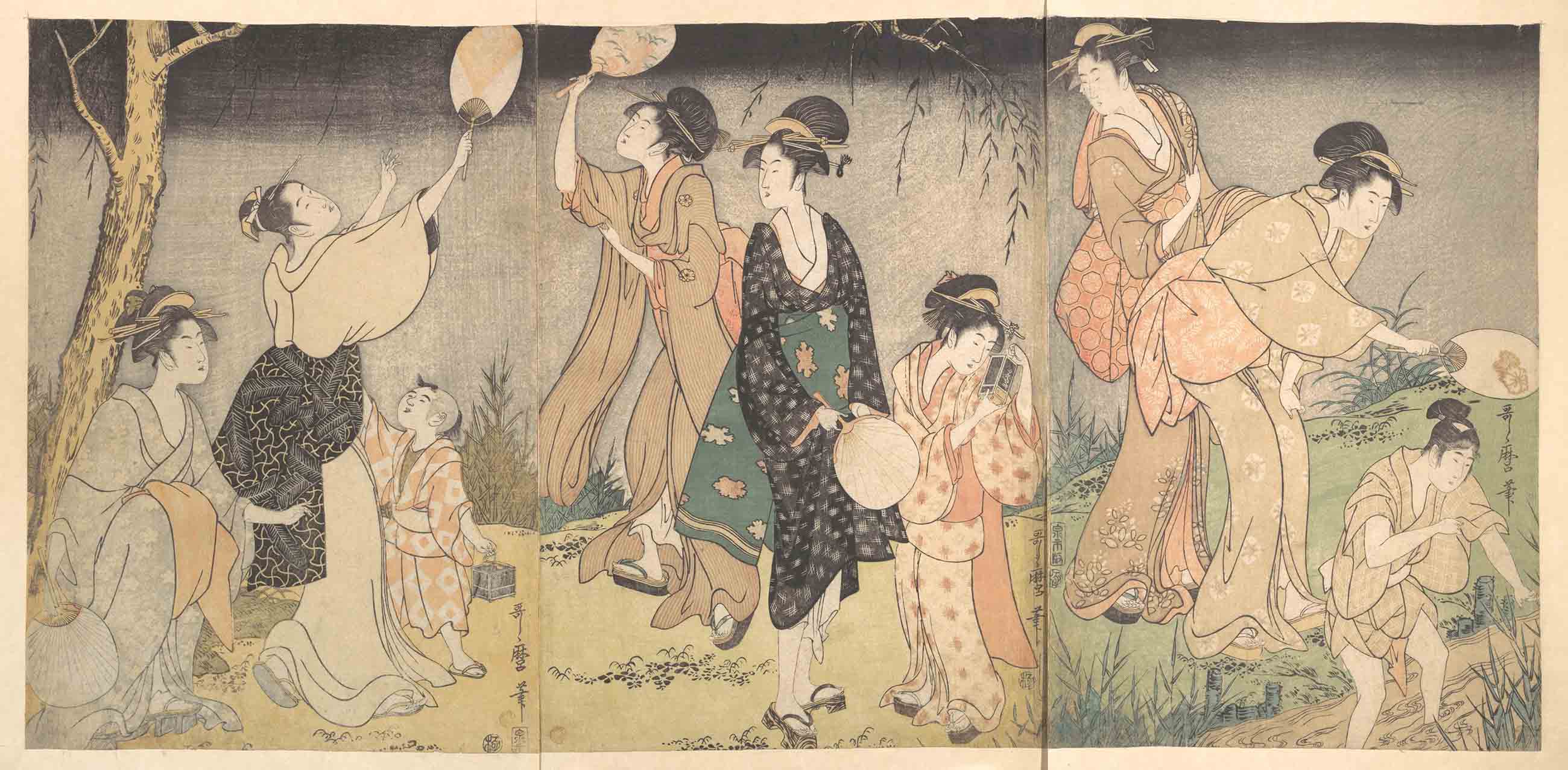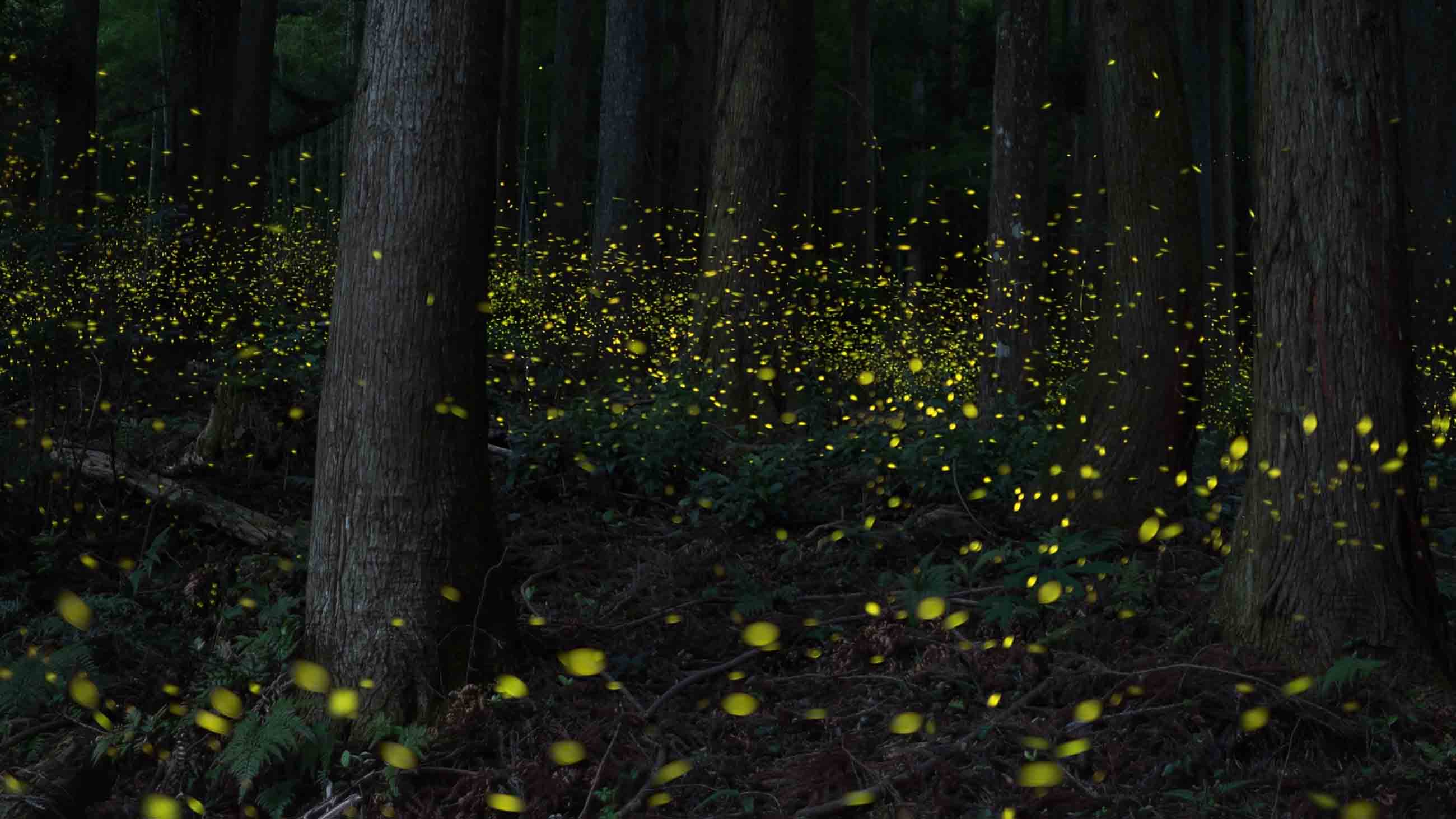For the Sake of Their Glow
Like a floating ember, the glowing insect settled lightly on her outstretched palm. The child held it gently in cupped hands, peering down at the luminous creature as fascination unfurled across her countenance. Watching, I suddenly understood this one firefly’s astonishing power. Right then and there, I realized that we might not need thousands, perhaps not even hundreds. Because even a single firefly can offer us the gift of wonder.

The city of Moriyama once provided ideal habitat for Genji fireflies.
Visual: Stephen Wheeler/Flickr
While this moment could have happened anywhere, it felt especially poignant here in Japan at the Moriyama Firefly Festival, or Hotaru Matsuri. Merely a century ago, Moriyama’s fabulous firefly displays were famous all over the country. In early summer, thousands of fireflies drifted gracefully, their leisurely glows decorating the night skies. Surely it must have seemed like they could never end! Yet within decades, fireflies were nearly extinguished from the Japanese countryside. Only by the grace of science and one man whose discoveries were fueled by firefly passion would they be rescued — albeit in numbers far smaller than once existed.
What on Earth happened to all of Moriyama’s fireflies? I learned their remarkable saga one summer while visiting the Moriyama Institute of Firefly’s Woods, a tiny wooden building in Moriyama that hides a treasure trove of ecological history. These Japanese fireflies were overexploited for their luminous beauty: Ironically, they were nearly loved to death.
Although the story is scarcely known beyond Moriyama, theirs is cautionary tale that shines across decades. Even today, firefly populations remain at risk in places like China, where commercial harvesting is a growing threat. What happened in Moriyama spotlights an undeniable truth: We must be proactive in protecting our natural resources.
Situated in Shiga Prefecture, the small city of Moriyama is nestled between the picturesque shores of Lake Biwa and the Suzuka Mountains. Once it was ideal habitat for Genji fireflies (Luciola cruciata), insects intimately connected to fast-flowing rivers and streams. Females lay their eggs among the moss that blankets the riverbanks. When these hatch, the juvenile fireflies crawl down the bank and enter the water. These aquatic larvae will spend several months living underwater, where they feed on the freshwater snails known as kawanina. Eventually the young fireflies crawl back onto the riverbank where they will undergo metamorphosis into their final, adult form. When the adults go a-courting their lime-green lights hover, slow and silent, over the water.
Japanese culture is exquisitely attuned to nature’s seasons, and fireflies have been long been celebrated as a welcome harbinger of summer. During the 19th and early 20th centuries, Moriyama was a renowned tourist hotspot for viewing fireflies. Hundreds of city dwellers flocked here, boarding special trains from Kyoto and Osaka just to admire the ethereal beauty of these Moriyama fireflies.
Traveling with friends, I visited Moriyama during the summer firefly festival. At the train station, we eagerly hopped aboard the free shuttle bus, then listened as cheerful volunteers explained exhibits about firefly ecology and life cycles. Vendors sold food and toys along the sidewalks, and children paraded in plastic caps illuminated with blinking LEDs. And yet … we saw surprisingly few fireflies. Across town, at the very best spot their numbers topped out one night at 131, while elsewhere between 0 and 78 fireflies showed up. Walking along a canal in a well-lit, commercial part of town, we joined the crowd of families, elders, and young lovers to admire some 20 flashers. Surely beautiful, but hardly evoking their former glory days. Why had Moriyama’s fireflies faded away into these few glowing ghosts?

Despite a deep appreciation for the natural world, the Japanese did not hesitate to exploit their natural resources. Moriyama sat at the epicenter as firefly tourism audaciously blossomed into commercial firefly hunting during the Meiji period (1868-1912). Live fireflies were the height of summertime fashion, and worth good money; Moriyama’s fireflies were particularly large-bodied, vigorous, and bright. Dozens of firefly wholesalers set up shop here, each hiring a small team of firefly hunters. Working sunset to sunrise, a single hunter could capture up to 3,000 wild fireflies each night. In the morning, shop owners carefully packed up the night’s catch and sent cages filled with live fireflies via express messenger to clients in Osaka, Kyoto and Tokyo. Moriyama’s fireflies were conscripted to decorate hotel, restaurant, and private gardens so that city dwellers could marvel at their radiant beauty. Each summer, the town also collected and offered their famous insects as gifts to honor Emperor Meiji. During a luminous nighttime celebration, thousands of live Moriyama fireflies were caged in elaborate paper-covered lanterns, held aloft, and paraded through town before being shipped off to the Imperial family in Tokyo.
Perhaps the lowest blow came from one peculiar hunting strategy favored by the firefly hunters. In 1902 Lafcadio Hearn, acclaimed interpreter of Japanese culture, described their method:
[T]he firefly catcher works until about two o’clock in the morning…at which time the insects begin to leave the trees and seek the dewy soil. There they are said to bury their tails so as to remain viewless…Taking a bamboo broom he brushes the surface of the turf, lightly and quickly. Whenever touched or alarmed by the broom, the fireflies display their lanterns, and are immediately nipped and bagged. A little before dawn the hunters return to town.
The ones “burying their tails” were female Genji fireflies who, once mated, gather along mossy riverbanks to lay their eggs. By inadvertently targeting these precious egg-bearing females, firefly hunters extinguished the only hope Moriyama’s fireflies had to replenish themselves. As the demand for live fireflies grew, wild populations began to shrink. By 1920, people noticed that Genji fireflies were flickering out.
Their decline galvanized into action a young man living in Moriyama named Kiichiro Minami, an ardent firefly lover. Although not trained as a scientist, Minami set out to decipher the complex life cycle of the Genji firefly, which was not yet known. With net in hand, he waded through local rivers where he discovered the aquatic firefly larvae, noted their habitat requirements, and recorded their food preferences. These juvenile fireflies favored one particular river snail, the kawanina. Minami went home and started raising young larvae that he gathered from local rivers. Using shallow ikebana pottery vases, he provided them with a steady supply of snails — the larvae grew rapidly! When they were big enough, he gave them trays of moist soil where the larvae could metamorphose into adults. After coaxing some adult fireflies to mate, Minami figured out what type of moss best suited the females for their egg-laying. And when these eggs hatched out, he started all over again.
By the 1930s, Minami and his disciples were releasing hundreds of captive-bred larvae back into Moriyama’s rivers every year to replenish depleted firefly populations. Similar techniques were eventually adopted all over Japan.
Meanwhile, though, Japan’s river habitats were under siege. Urban and industrial development had degraded water quality, as industrial effluent, agricultural runoff, and household sewage flowed into rivers. Kawanina snails could not survive, and starving firefly larvae died en masse. Municipal flood control projects rerouted rivers and built concrete embankments, destroying the mossy riverbanks Genji females rely on. To reverse such degradation, in 1924 the Japanese government established a Special Natural Monument in Moriyama to provide legal protection for Genji firefly habitat, and banned commercial firefly harvesting.
As the importance of river protection became obvious, many local communities started municipal projects to clean up their rivers and restore suitable firefly habitat. Attracting strong public support and enthusiastic participation by schoolchildren, the elderly and other volunteers, the revival of Moriyama’s fireflies ignited a fervent environmental movement that spread throughout Japan. Today, the Moriyama Firefly Festival celebrates not just the Genji fireflies and summer’s arrival, but also the scientific discoveries that helped rescue these insects from the brink of extinction. Japan’s fireflies may never be restored to their former glory, but populations have rebounded and now, perhaps, they elicit an even deeper appreciation.
More than 2,000 different firefly species exist worldwide, and we’re fortunate to have many places where they still thrive. Today, our fireflies might seem like an inexhaustible resource. Yet what happened in Moriyama could happen anywhere. During the late 20th century, collectors in the United States gathered and sold some 100 million fireflies to extract luciferase, their light-producing enzyme. In recent years, online sales of wild-harvested fireflies have skyrocketed in China, as these make popular gifts during Qixi, a romantic holiday. Even today, many fireflies face escalating threats from urbanization, habitat loss, light pollution, and ecotourism.
If we take Moriyama’s lessons to heart, we might safeguard our beloved fireflies before it is too late. We might ban the commercial harvesting of wild fireflies. We might protect especially vulnerable species and their habitats. We might install outdoor lighting that does not interfere with firefly signals. We might implement ethical practices for firefly-watching at eco-tourist sites. Above all, we might advocate for firefly conservation at the local, regional, national, and international levels.
Think about extinguishing a roomful of candles, one by one. You may not even notice when the first few flames flicker out, but in the end, you are left sitting in darkness. Perhaps we don’t need thousands, or even hundreds, of fireflies. But my dream for future generations is that each child can hold a single firefly, for just a moment.
That’s all it takes to spark a lifetime’s worth of wonder.
Sara Lewis is the author of “Silent Sparks: The Wondrous World of Fireflies,” and a professor in the Department of Biology at Tufts University. Over the past 30 years, her scientific research has revealed many intimate secrets of firefly sex and death. In addition to giving a TED Talk in 2014, Lewis has written about firefly conservation and evolution for Natural History, CNN, and The Guardian.











Comments are automatically closed one year after article publication. Archived comments are below.
I am blessed with 2-3 weeks of fireflies in my Shiga (Japan) backyard. Thankfully, my little town is less well known, thus allowing the insects a bit of peace. Nevertheless, I have heard that several decades ago, aerial spraying of pesticides nearly wiped ours out too.
Growing up in northeastern Massachusetts, I remember seeing a great many fireflies in the field behind my house. There was no running water there; so I don’t know where they bred/developed. Similarly, fidteen or so years ago, I was surprised to see a good number of the bugs in the open green areas on Pennsylvania Avenue in D.C.
I live on an acre of woods in Chapel Hill, North Carolina. I happily allow grasses to grow at will. I’m somewhat plagued with mosquitoes but greatly rewarded with masses of fireflies. Snakes and turtles share this space. Birds abound All around my property are houses in home owner associations that dictate the height of lawn grasses, leaves must be raked and other stifling demands. I never have to rake or mow or water and again rewarded with a natural space.
I never see them in Minneapolis anymore and I sure did when I was growing up in the 60’s. This is heartbreaking.
Thank you for this touching overview of the Japanese fireflies-experience. Yes, we should do everything possible to keep this drama from repeating itself all over the world. Fireflies are too precious, their sparkle too important for this increasingly gloomy planet.